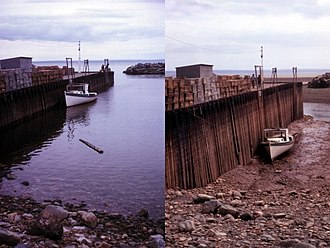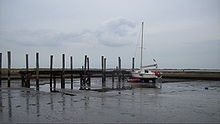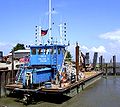Watercraft drying out

As a drying up of vessels , it is called when a watercraft tidenbedingt on a flat area in the sea ( Dry Falling Field ) by the falling water level at the bottom touches down and then dry on the ocean floor is.
requirements
In order for a watercraft to dry out, the draft of the watercraft must be greater than the mean water depth minus half the tidal range . Areas that fall dry are marked on the nautical chart. The underlined numbers on the areas indicate how high the areas protrude from the water at low tide.
If a watercraft wants to run dry, it has to go to a point at high tide that at low tide falls dry at least as high as its own draft. Either the watercraft hits this flat spot on purpose or it drops an anchor . When the water runs off, the vehicle then slowly sinks to the sea floor as the water level drops. If the vehicle is lying on the ocean floor, the remaining water will eventually run out from under the vehicle until it finally lies dry on the ocean floor without any water.
So that the vehicle does not fall over, it should have a flat floor, e.g. B. Flat bottom ships . Sailboats with Kimmkielen or multihulls can also dry out. For ships with only one keel , watt supports are necessary, which are usually attached to the ship's side with a bolt amidships and held vertically by a rope stretched fore and aft. The mud flats do not quite reach the level of the keel sole, so that the yacht is only supported by them and rests on the keel. Another method is to lean the yacht against a quay wall. Many modern yachts are not designed for the stress of standing just on the keel and cannot fall dry.
A watercraft will fall very dry if it touches the bottom soon after flooding. It falls low dry when it touches down shortly before low tide, just dry shortly before it floats again.
When falling dry, care should be taken to ensure that the water is never too high to ensure that the next flood causes the watercraft to float up again so that it can continue its journey. To ensure this, a watercraft should only be allowed to dry out when the water is running down, preferably with an interval of one hour before the flood, and the water level forecasts for the next tide should be observed.
Let it dry for fun
Many pleasure craft let themselves be dried out on purpose in the Wadden Sea to go for a walk in the mudflats or to rest for a few hours or to save the overnight fee for a port. Those who let themselves dry to rest should let themselves dry as high as possible (but not too high).
Let dry for repairs
Some watercraft can also be deliberately dried out in order to check the ship's underbody, which is otherwise in the water, or to carry out small repairs.
Let dry for loading and unloading
Dropships can dry themselves out on a beach or other coastal location where there is no port to load or unload construction equipment or materials.
hazards
If a ship falls dry at spring tide and after full tide, where there is hardly any water under the hull, it has to wait until the next spring tide because a normal tide does not bring enough water to make the ship float again. If the tide builds up with corresponding waves after it has fallen dry, it can happen that the ship hits the bottom due to waves as it floats and may suffer damage to the bottom as a result. However, it can also happen that a ship accidentally runs aground when the water runs out and does not come free again until the next tide. When the tide comes up, an anchor should be placed in the direction of the returning water to avoid the current or wind pushing the ship into even shallower areas when floating up.
In rough weather with high waves, falling dry is dangerous for the ship because it can repeatedly hit the ground or be dragged over it during the landing or floating phase.
In the event of unfavorable ground conditions, the vehicle may seize up in conjunction with the shape of the hull. In extreme cases, the ship is flooded before it floats.
Two flat bottom ships - fallen dry off Terschelling
A work pontoon that has fallen dry in the harbor of Fedderwardersiel
A flat-bottomed ship that has fallen dry near Westerhever
A small sailing yacht and a dinghy that fell dry at Schiermonnikoog





